|
With the commercial airline industry and military
strategic and logistic air operations moving inexorably into the jet age, demand
was high for skilled airframe and powerplant (A&P) mechanics. The military took
care of its own training, but the civilian world also desperately needed technicians
to maintain their hardware. For that matter, even highly experienced veterans usually
needed to receive specialized training to qualify for working on the models of engines
and airframes sold for civilian use. As you probably know, many models of both airplanes
and engines had both military and civilian versions, so a lot of similarity existed,
but with the huge investment in equipment and human lives at stake, total familiarity
with complete systems was (and still is) essential. Model and full-size aviation
magazines published many articles like this one in a 1967 issue of American
Modeler magazine in order to coax people into the field. Promises of good pay, career
security and advancement, job satisfaction, and prestige were all promoted heavily.
Unfortunately, I do not yet own the previous issue which contained Part I of
this series. Here is the
A&P Sample Test.
Wanted: A & P Mechanics - Part II
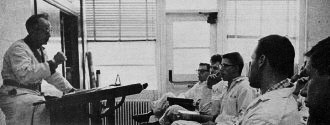
Students listen attentively to instructor at one of the 79 Federal
Aviation Agency certificated schools. A complete listing is given at the end of
this article.
How to qualify for a license. Where to study. FAA certificated schools, skills
and knowledge required. What the FAA examinations cover.
By Walter Zaharevitz and Dr. Mervin K. Strickler, Jr.
(Mr. Zaharevitz is Executive Director, National Aerospace Education Council.
Dr. Strickler is Special Assistant for Aviation Education, Office for General
Aviation Affairs, Federal Aviation Agency.)
Aviation is not inherently dangerous but to an even greater extent than the sea,
it is terribly unforgiving of any carelessness, incapacity or neglect. Safety of
aircraft is delegated through various levels hut in the final analysis it is the
mechanic working on the aircraft who has this responsibility. - An aviation axiom
Last month's portion of this article emphasized the following factors in relation
to the A&P mechanic: the importance of education, the basic characteristics
necessary for a good A&P mechanic, the nature of the work, wages, the demand,
high school courses related to aviation mechanic tasks, how to get started, and
the importance of the aviation mechanic. It also included the Aviation Mechanic's
Creed.
This concluding portion of the article will provide you with information on how
to qualify for an A&P mechanic's license (certification).
Where to Study
There are two main avenues for you to become an FAA-licensed A&P mechanic.
Experience can be gained by: 1) attending an FAA-certificated mechanic school, or
2) by performing, for a specified period of time, the duties appropriate to the
rating.
An applicant for either the A or the P rating must show he has performed the
duties appropriate to that particular rating for a period of at least 18 months.
For both ratings, concurrently, 30 months of experience are required. In any case,
applicants for a license who follow the experience route or those who attend mechanic
school must pass FAA oral, written, and practical examinations. The age minimum
for an A and/or P rating is 18. You cannot have the license issued to you before
your 18th birthday.
FAA Certified Schools
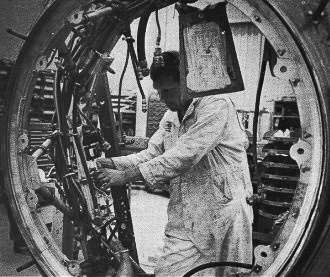
Alternate route to a rating is to perform for a specified period,
duties appropriate to the rating. Either way, FAA oral, written and practical exams
must be passed.
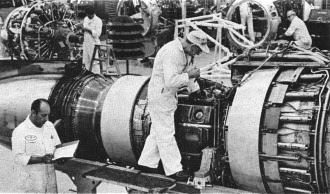
Users of piston and/or jet engines offer distinct employment
opportunities to the student who "sticks it out." The military offers valuable in-service
experience.

Private aviation, most especially in business flying, required
men like these who here service a flat-four engine.

Mechanic, working on hydraulic system of a landing gear, is symbolic
of today's specialized society.
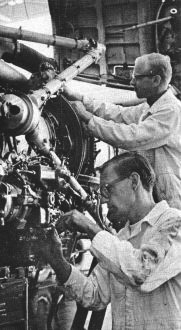
Working on powerful turboprop, these painstaking craftsmen compare
favorably with skilled in other vital professions.

FAA certified mechanic schools as of August 1, 1966.
As of August 1, 1966, the Federal Aviation Agency listed 79 certificated mechanic
schools.
These schools are one of four types: 1) A high school and adult education trade
school program; 2) A public school vocational and technical program; 3) A two-year
associate in arts degree program (community or Junior college.) 4) A four-year baccalaureate
degree program (college or university).
In picking the right school for you, some selection guidelines may be helpful:
1. The program should be directly related to employment opportunities, determined
by school officials in cooperation with the aviation community and competent individuals
and groups.
2. The course content should be confirmed or changed after periodic evaluations
and job analyses of aviation mechanic performance.
3. The course content should be set up and maintained with the advice and cooperation
of the school officials, the FAA, and the appropriate representatives of the aviation
community.
4. The facilities and equipment to be used in instruction should be comparable
to those found in the aviation community.
5. The conditions under which instruction is given should duplicate as nearly
as possible desirable conditions in the aviation community itself and at the same
time provide effective learning situations.
6. Training should be carried to the point of marketable skills, abilities, understandings,
attitudes, work habits, and appreciations sufficient to enable the student to obtain
a job at the completion of the course.
7. Instructors should be competent and possess adequate qualifications for teaching.
8. Continuous research on the part of the schools and their staffs should be
an integral part of the school program.
Knowledge and Skill Requirements for the A&P Mechanic Rating
The Federal Aviation Regulations require each applicant for a mechanic certificate
or additional rating to demonstrate that he meets the knowledge requirements by
passing a written examination. The tests cover the construction and maintenance
of aircraft appropriate to the rating; the Regulations pertaining to the certification
of, and operating rules for mechanics; the applicable provisions of the Regulations
that deal with maintenance, repair, and alteration of aircraft; and general operating
rules.
Skill requirements, like experience and knowledge, are related to the rating
sought. The Federal Aviation Regulations require each applicant for a mechanic certificate
or rating to pass an oral and a practical test for the rating he seeks. The tests
cover the applicant's basic skill in performing practical projects in the same general
subject areas covered by the written test for that rating.
What Areas Do Examinations Cover?
The subjects with which mechanic examinations are concerned are arranged into
three categories: 1) general, which relates to both airframe and powerplant ratings;
2) airframe, which relates to the airframe rating only; and 3) powerplant, which
relates to the powerplant rating only.
1. General Subjects:
a) Mechanic Privileges and Limitations b) Official FAA Publications, c) Various
Maintenance Forms and Records, d) Basic Physics, e) Basic Mathematics, f) Maintenance
Publications, g) Mechanical Drawing, h) Aircraft Weight and Balance, i) Basic Handtools
and Measuring Devices, j) Basic Aerodynamics, k ) Nondestructive Testing, l) Basic
Electricity; m) Batteries; n) Aircraft Maintenance Equipment, Techniques, and Practices;
o) Safety Practices; p) Inspection Procedures and Techniques; q) Fuels and Fuel
Systems.
2. Airframe Subjects
a) Theory of Flight, b) Flight Control Systems, c) Cleaning and Preservation,
d) Assembly and Rigging, e) Aircraft Finishes, f) Aircraft Covering, g) Aircraft
Structures, h) Structural Materials, i) Procedures and Techniques, j) Aircraft Hydraulic
Systems, k) Hydraulic Fluids, I) Hydraulic Pumps and Actuators. m) Hydraulic Pressure
and Flow Control, n) Aircraft Landing Gear, o) Aircraft Pneumatic Systems, p) Aircraft
Fire Detection and Control Systems, q) Cabin Atmosphere Control, r) Aircraft Instrument
Systems, s) Airframe Ice Detection and Control Systems, t) Aircraft Communication
and Navigation Systems, u) Generators and Generator Control, v) Motors and Motor
Control, w) Aircraft Electrical Systems.
3. Powerplant Subjects
a) Basic Carburetion, b) Induction Systems, c) Float-type Carburetors, d) Pressure
Carburetors, e) Direct Fuel Injection Systems, f) Carburetor Systems, g) Turbine
Fuel Control, h) Superchargers and Impellers, i) Basic Ignition, j) Magnetos, k)
Ignition Wiring, l) Turbine Ignition. m) Spark Plugs and Igniters, n) Starting Aids,
o) Basic Engine Principles, p) Engine Operation, q) Engine Installations, r) Engine
Instruments, s) Exhaust Systems, t) Cooling Systems, u ) Engine Maintenance Procedures
and Techniques, v) Basic Lubrication. w) Lubrication Systems, x) Basic Propeller
Principles, y) Propeller Operation, z) Propeller Installations, aa) Variable Pitch
Propellers, bb) Propeller Maintenance Procedures and Techniques, cc) Generators
and Generator Control, dd) Motors and Motor Control, ee) Aircraft Electrical Systems.
Sample Oral Examination Questions
Some examples of the type of questions asked during the oral examination are:
1) What is a blind rivet and how is it used?
2) What is the difference between welding and brazing?
3) What is a circuit breaker and how does it work?
4) What are two causes of vapor lock in a fuel line?
5) Which cylinder should be removed last during the disassembly of a radial aircraft
engine?
6) How would you check a propeller for correct track?
7) How is the moment of an item of equipment determined in computing aircraft
weight and balance?
Typical Practical Examination Projects
The following are typical of the projects assigned during the practical examination:
1) Make a sheet metal splice.
2) Make a steel tube welded splice.
3) Compute empty weight center of gravity and the most forward and rearward loaded
center of gravity of an aircraft.
4) Time the valves of an engine.
5) Install and time engine magnetos.
6) Remove and install a propeller.
Remember: you may obtain more information and assistance regarding A&P mechanics
as a possibility for your career from the following sources:
1) Your school counselor, teacher, and/or librarian.
2) Your state employment office.
3) Your local airport.
4) Your public library.
An additional possibility for exceptionally capable young men is United Air Lines'
rapidly growing Apprentice Mechanic Program-on-the-job training conducted at their
San Francisco and Chicago locations. You may obtain a copy of United's new brochure
outlining its complete career program for people interested in becoming aircraft
mechanics by writing to the United Air Lines, Education and Training Center, P.
O. Box 8776, O'Hare International Airport, Chicago, Illinois, 60666.
Test Your Knowledge
To find out something about what an A&P written examination is like and to
test your knowledge of some of the things an aviation mechanic needs to know, try
the following test based on sample written examination questions that are like those
on an FAA mechanic's examination. (You can check your answers with the correct answers
given below).
1. What must a certificated mechanic with both airframe and powerplant ratings
do prior to returning to service an aircraft on which he has performed and approved
a 100-hour inspection?
1) Make the proper entries in the appropriate logbooks.
2) Present his work and records to a mechanic holding an Inspection
Authorization for final approval and release.
3) Complete the required copies of Form FAA-337, including an accurate
description of the work performed, date, mechanic's name, and certificate number.
4) Notify the local FAA maintenance inspector in writing of his intention
to return the aircraft to service.
2. If the container volume of a confined gas is doubled (assume temperature remains
constant) the pressure will:
1) Increase in direct proportion to the volume increase.
2) Remain the same.
3) Be doubled.
4) Be reduced to one-half its original value.
3. As the velocity of the air across an airplane wing increases, the pressure
of the air on the upper-surface:
1) Increases.
2) Decreases.
3) Drops to zero.
4) Remains unchanged.
4. If the cross-section area of a given conductor is increased to four times
its original value and the length and temperature remain constant, the resistance
of the conductor wilt be:
1) One-fourth its original value.
2) Four times its original value.
3) The same as its original value.
4) Found by multiplying the original resistance by the percentage
increase in cross-sectional area.
5. Which of the following sequences of connecting and tightening the battery
leads should result in the safest procedure of installation of a battery in an aircraft
with a single wire ground-return electrical system?
1) Connect and tighten the negative (ground) lead before connecting
the positive lead.
2) Connect the negative (ground) lead, connect the positive lead,
then tighten in the same order.
3) Connect the positive lead, connect the negative (ground) lead,
then tighten in the same order.
4) Connect and tighten the positive lead before connecting the negative
(ground) lead.
6. Which of the following has tittle or no effect upon the rate of vaporization
of a given fuel?
1) The pressure of the surrounding air.
2) The temperature of the fuel.
3) The temperature of the surrounding air.
4) The antiknock value of the fuel.
7. If an aircraft is cruising in level flight and the stick or control column
is moved forward the elevator will:
1) Go down and the nose of the aircraft will go down.
2) Go up and the nose of the aircraft will go down.
3) Go down and the nose of the aircraft will go up.
4) Go up and the nose of the aircraft will go up.
8. Which of the following is not indicated by the aluminum sheet designation
ALCLAD 2024-T36?
1) The specific process or combination of operations used to produce
the stable temper.
2) The nominal thickness of the sheet.
3) Major alloying element.
4) Method used to produce stable temper (whether strain hardened
or heat treated) .
9. If it is necessary to adjust several valves in a hydraulic system, what particular
sequence, if any, should be followed?
1) Units with the highest pressure settings are adjusted first.
2) Units with the lowest specified pressure settings should be adjusted
first.
3) Units are independent of each other and therefore no particular
sequence is necessary.
4) Units most distant from the hydraulic pump should be adjusted
first.
10. Shuttle valves installed in large aircraft braking systems allow:
1) Two independent systems to operate the same actuator if necessary.
2) The safe application of brakes regardless of ground speed due
to the compensating action of the valves.
3) Fluid to bypass from the right wheel cylinder to the left wheel
cylinder if braking pressures are different.
4) The compensating port, interconnecting both master cylinders,
to discharge fluid alternately from one to the other.
11. Built-in aircraft fire extinguishing systems ordinarily are charged with:
1) Carbon dioxide and nitrogen.
2) Carbon tetrachloride.
3) Sodium bicarbonate.
4) Freon and nitrogen.
12. Instrument static system leakage can be detected by observing the rate of
change in indication of the:
1) Altimeter after pressure has been applied to the static system
to cause a prescribed equivalent altitude to be indicated.
2) Airspeed indicator after pressure has been applied to the static
system to cause a prescribed equivalent airspeed to be indicated.
3) Altimeter after suction has been applied to the static system
to cause a prescribed equivalent altitude to be indicated.
4) Airspeed indicator after suction has been applied to the static
system to cause a prescribed equivalent airspeed to be indicated.
13. What effect wilt increased generator voltage have on the strength of the
electromagnet which controls the pressure applied to the stack of carbon discs in
a carbon pile voltage regulator?
1) Both magnet strength and the pressure applied to the carbon discs
will increase.
2) Both magnet strength and the pressure applied to the carbon discs
will decrease.
3) Magnet strength will decrease and the pressure applied to the
carbon discs will increase.
4) Magnet strength will increase and the pressure applied to the
carbon discs will decrease.
14. What effect wilt increased humidity have on engine power output?
1) No appreciable change in power output.
2) Power output will decrease at all altitudes.
3) Power output will increase at all altitudes.
4) No effect at sea level but greater power output at altitude.
15. Aircraft engine direct cylinder fuel injection systems normally discharge
fuel into each cylinder during which stroke(s)?
1) Compression.
2) Intake.
3) All (continuously).
4) Intake and compression.
16. When a single-stage, two speed supercharger is shifted from low to high impeller
ratio during a ground check there should be:
1) A momentary drop in oil pressure, no drop in manifold pressure,
and no change in RPM. /p>
2) A momentary drop in oil pressure, a slight rise in manifold pressure,
and an increase in RPM.
3) No drop in oil pressure, no drop in manifold pressure, and an
increase in RPM. /p>
4) No drop in oil pressure, a slight drop in manifold pressure, and
a decrease in RPM.
17. Which statement about the ignition system of a turbojet engine is correct?
1) It is a low voltage, high amperage system.
2) The engine will operate normally after start if the ignition system
is deenergized.
3) The engine will not continue to operate after start if the ignition
system is deenergized.
4) The system generally includes a polar inductor type magneto.
18. Thermocouple type temperature indicating instrument systems:
1) Require no external power source.
2) Are classed as balanced type, variable resistor circuits.
3) Usually contain a balancing circuit in the instrument case to
prevent fluctuations of the aircraft electrical system , voltage from affecting
the temperature reading.
4) Will not indicate a true reading if the aircraft electrical system
voltage varies beyond the range for which the instruments are calibrated.
19. Which of the following is referred to as the propeller blade face?
1) The root end of a propeller blade.
2) The flat side of a propeller blade.
3) The cambered side of a propeller blade.
4) The cuff around a propeller blade.
20. Select the proper sequence to be followed when using the etching process
as an inspection method for determining the surface condition of an aluminum alloy
propeller blade.
1) Nitric acid etch, water rinse.
2) Nitric acid etch, caustic bath, water rinse.
3) Abrasive cleaning, nitric acid etch, water rinse, caustic bath,
water rinse.
4) Abrasive cleaning, caustic etch, water rinse, nitric acid bath,
water rinse.
See answers below.
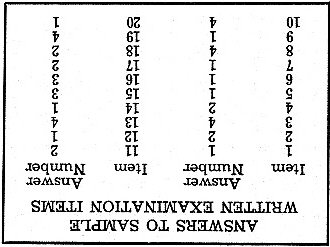
Posted January 27, 2022
|




